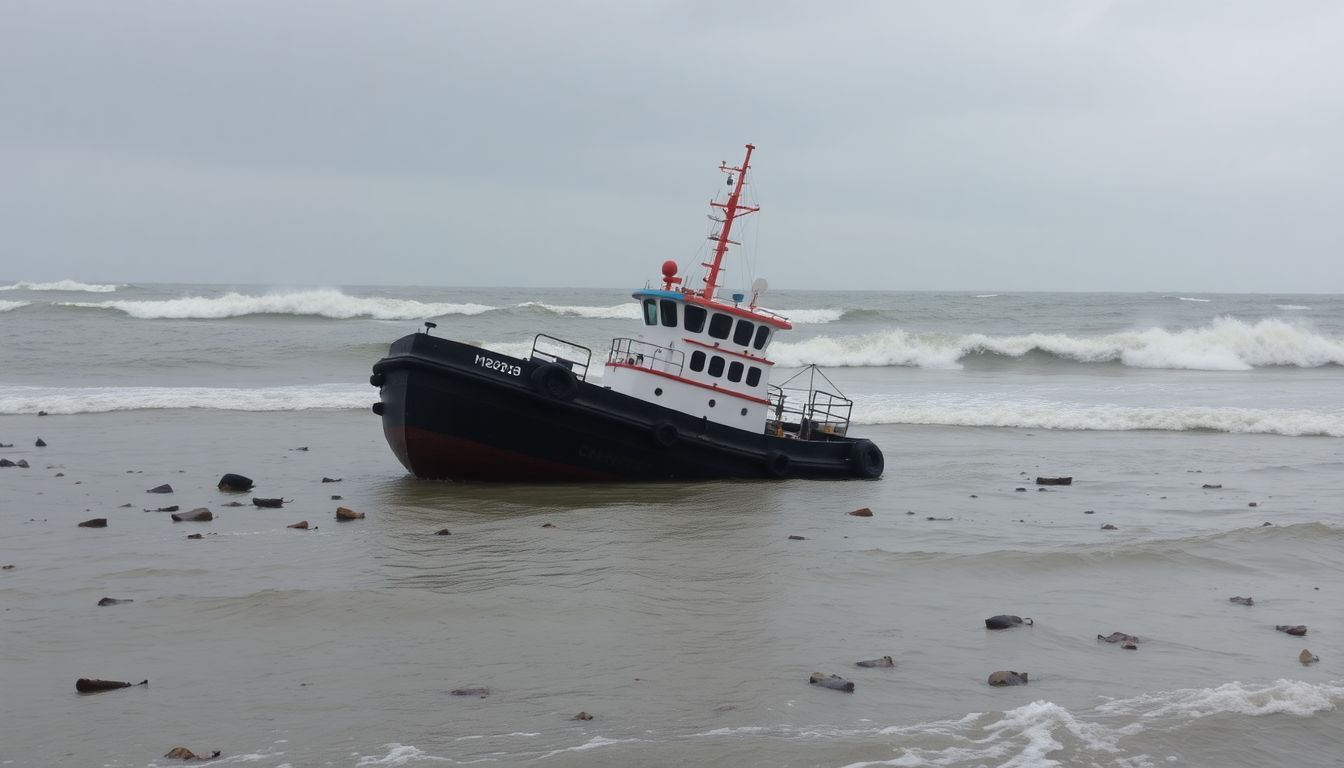Tugboat accidents can cause serious injuries and financial hardship for workers. Each year, many tugboat crew members face risks on the job. This article explains how injured workers can get compensation after a tugboat accident.
Learn about your legal rights and options for recovery.
Key Takeaways
- Tugboat accidents often result from human error (75% of cases) and mechanical failures, especially in boats over 20 years old (61% of accidents from 2008-2017).
- The Jones Act allows injured tugboat workers to sue employers for negligence, covering medical costs, lost wages, and pain and suffering.
- Workers have 3 years to file most maritime injury claims, starting from the date of injury or when they first learn of the harm.
- Common tugboat injuries include rigging and towing injuries, slip-and-falls, snap-back injuries, and overboard incidents.
- Maritime law firms like Montagna Law offer free consultations and work on a no-win, no-fee basis, having won over $30 million for maritime injury cases.
Common Types of Tugboat Accidents

Tugboat accidents can occur in various ways, often with serious consequences. Here are the most common types of accidents that happen on tugboats:
- Ship collisions: Tugboats frequently work in close quarters with larger vessels, increasing the risk of collisions. These accidents can cause severe damage to both boats and injure crew members.
- Crew member accidents: Slip-and-falls are a major hazard for tugboat workers. Wet decks, loose equipment, and sudden boat movements can lead to injuries ranging from minor bruises to broken bones.
- Engine malfunctions: Mechanical failures plague many older tugboats. In fact, 61% of accidents between 2008 and 2017 involved boats over 20 years old due to engine problems or other mechanical issues.
- Overturned boats: While rare, capsizing is one of the most dangerous accidents for tugboats. These incidents often result in fatalities due to the sudden nature of the event and the difficulty of escaping a sinking vessel.
- Inadequately secured lines: Heavy lines and shackles used in towing operations can cause serious injuries if not properly secured. Workers may be struck by loose equipment or caught in ropes, leading to crushing injuries or falls overboard.
- Fire and explosions: Tugboats carry large amounts of fuel, which can ignite under certain conditions. Fires on board can spread quickly, trapping crew members and causing severe burns or smoke inhalation.
- Groundings: Tugboats sometimes run aground in shallow waters or on hidden obstacles. These accidents can damage the hull, strand the crew, and potentially lead to sinking if the damage is severe.
Leading Factors Contributing to Tugboat Accidents
Moving from common types of tugboat accidents, we now explore the main causes behind these incidents. Human error stands out as the primary factor, accounting for 75% of all tugboat accidents.
This high percentage stems from various issues, including crew training deficiencies, staffing problems, and captain mistakes. Negligence from owners or captains also plays a big role in these accidents.
Mechanical failures form another key factor in tugboat incidents. A study from 2008 to 2017 found that 61% of accidents involved tugboats older than 20 years. Aging vessels are more prone to breakdowns, increasing the risk of accidents.
Vessel transitions, such as docking or undocking, also raise the chances of incidents occurring. These factors, combined with human errors, create a complex web of risks for tugboat operations.
Safety at sea is not a matter of luck, but of proper training and vigilance.
Common Injuries Sustained in Tugboat Accidents
Tugboat accidents can lead to severe injuries for crew members. These injuries often result from the unique hazards of working on a vessel in challenging maritime conditions.
- Rigging and towing injuries: Crew members can suffer cuts, bruises, or crushing injuries from ropes, cables, or winches used in towing operations.
- Slip-and-fall accidents: Wet or slippery decks increase the risk of falls, causing broken bones, head injuries, or back problems.
- Snap-back injuries: Sudden tension release in ropes or cables can cause whiplash-like injuries or blunt force trauma to workers.
- Overboard incidents: Falling into water can result in near-drowning, hypothermia, or injuries from collisions with the vessel or other objects.
- Fractures: The unstable nature of tugboat work can lead to broken bones in arms, legs, and ribs during accidents or falls.
- Traumatic brain injuries: Concussions and other head injuries can occur from falls, falling objects, or collisions on board.
- Burns: Fires or explosions on tugboats can cause severe burns to crew members.
- Spinal cord injuries: Heavy lifting, falls, or impacts can damage the spine, leading to partial or full paralysis.
- Crush injuries: Workers can be caught between the tugboat and other vessels or structures, resulting in severe tissue damage.
- Respiratory problems: Exposure to harmful fumes or chemicals on board can cause long-term lung issues for crew members.
Legal Protections for Injured Tugboat Workers
Injured tugboat workers have strong legal protections under maritime law. The Jones Act gives seamen the right to sue their employers for injuries caused by negligence. This law covers medical costs, lost wages, and pain and suffering.
Workers can also get “maintenance and cure” benefits, which pay daily living expenses and medical care until they heal. These no-fault benefits start right away, even before fault is decided.
I’ve seen firsthand how these laws help injured workers get back on their feet. In one case, a deckhand with a severe back injury got full pay and medical treatment for months while recovering.
The company had to cover all costs under maintenance and cure. Later, he won a large settlement in a Jones Act lawsuit for the company’s unsafe practices. These legal protections make a huge difference for maritime workers hurt on the job.
How the Jones Act Protects Injured Tugboat Workers
Building on the legal protections for injured tugboat workers, the Jones Act offers specific safeguards for maritime employees. This federal law allows tug and barge workers to seek compensation for injuries caused by unsafe conditions or negligence.
The Act covers workers in U.S. maritime regions, including Puget Sound, the Columbia River, and Alaska.
Under the Jones Act, injured seamen must prove employer fault to receive compensation. This differs from standard workers’ compensation claims. Compensation can include medical expenses, lost wages, pain and suffering, and future economic losses.
My experience as a maritime lawyer has shown that these cases often result in higher payouts than typical workplace injury claims. The Act’s broad coverage helps ensure fair treatment for tugboat workers facing dangerous conditions at sea.
Determining Fault in Tugboat Accident Cases
Moving from Jones Act protections, we now explore how fault is determined in tugboat accident cases. Tugboat collisions often involve complex factors. Courts use tort law to decide who’s at fault.
They look at things like operator error, speeding, bad weather, and equipment failures. Experts study the accident scene and gather witness accounts. They check if the boat operator was careless or if faulty parts caused the crash.
I once worked on a case where a tugboat hit a bridge. We found the captain was texting while steering. This clear negligence made the company liable for damages. In another instance, a broken rudder caused a crash.
The maker of the faulty part had to pay for injuries. Each case is unique, but careful study always reveals the truth behind maritime accidents.
Recovering Damages in Tugboat Accident Lawsuits
Injured tugboat workers can seek damages through lawsuits to cover their losses. These claims often include lost wages, medical costs, and pain and suffering. The Jones Act allows seamen to sue for negligence, while unseaworthiness claims target vessel owners.
Lawyers play a key role in building strong cases and proving fault. They gather evidence, interview witnesses, and work with experts to show how the accident happened.
Successful lawsuits can result in large payouts for injured workers. Courts may award compensation for past and future medical care, lost earning capacity, and emotional distress. In some cases, punitive damages might be available if the employer’s actions were very reckless.
The next section will explore the main safety issues tugboat operators face daily.
Additional Information on Tugboat Accident Claims
Tugboat accident claims involve complex legal processes. Workers must know their rights and deadlines for filing claims.
What Are the Main Safety Concerns When Operating a Tugboat?
Tugboat operations involve unique safety challenges due to their specialized role in maritime activities. Operators must stay alert to several key safety concerns to prevent accidents and injuries.
- Snapback zone dangers: Metal hawser lines can snap under tension, creating a hazardous “snapback” zone where crew members risk severe injuries.
- Capsizing risks: Unstable conditions can lead to tugboat capsizing, especially during towing operations or in rough waters.
- Equipment failures: Mechanical issues with engines, winches, or other vital systems can compromise safety and operational effectiveness.
- Collision hazards: Tugboats face risks of colliding with other vessels or structures, especially in crowded ports or narrow waterways.
- Line handling injuries: Improper handling of tow lines or cables can result in crushing injuries, falls, or entanglement.
- Stability concerns: Changes in load distribution or sudden movements can affect a tugboat’s stability, increasing accident risks.
- Weather-related dangers: Harsh weather conditions can create dangerous situations for tugboat crews, including high waves and reduced visibility.
- Fatigue-induced errors: Long work hours and demanding schedules can lead to crew fatigue, increasing the likelihood of mistakes.
- Communication breakdowns: Poor communication between crew members or with other vessels can result in accidents or misunderstandings.
- Fire hazards: Fuel leaks, electrical malfunctions, or improper storage of flammable materials can pose fire risks on tugboats.
Who Qualifies as a Jones Act Seaman?
Safety concerns on tugboats link closely to who qualifies for Jones Act protection. The Jones Act covers maritime workers with a strong tie to a vessel or fleet. To qualify, a worker must spend at least one-third of their time on a vessel “in navigation.” This means the boat can’t be permanently moored.
The law applies to many jobs, like deckhands, engineers, and cooks. It protects crew members on various vessels, including tugboats, barges, and offshore rigs.
Seafarers must work on the same vessel or fleet under one owner to be covered. The Jones Act aims to protect maritime laborers who face unique risks at sea. It offers more benefits than standard workers’ comp, including the right to sue for negligence.
Merchant mariners, offshore workers, and other vessel crew often meet the criteria for Jones Act seamen status.
Filing Deadlines for a Tugboat Accident Claim
Moving from who qualifies as a Jones Act seaman, we now turn to the crucial matter of filing deadlines for tugboat accident claims. Time limits play a key role in these cases. The law sets a three-year statute of limitations for most maritime injury claims, including those under the Jones Act.
This period often starts from the date of the injury. But in some cases, it may begin when the worker first learns of the harm. Quick action is vital. Filing accident reports right after an incident helps protect your legal rights.
Our firm has seen many cases where prompt reporting made a big difference in the outcome.
Knowing these deadlines is critical for injured tugboat workers. Missing the filing window can mean losing the right to seek damages. We’ve helped many clients navigate these time limits successfully.
In one case, a deckhand filed just days before the deadline, allowing him to recover fair compensation. The key is to act fast and get expert help. Don’t let time slip away if you’ve been hurt in a tugboat accident.
Hiring a Maritime Lawyer for Tugboat Accidents
Tugboat accident victims need skilled legal help to get fair compensation. Maritime law firms like Montagna Law offer expert guidance for these complex cases. They provide free consultations and work on a no-win, no-fee basis, reducing financial risk for clients.
Montagna Law has a strong track record, winning over $30 million in recoveries for maritime injury cases.
Injured tugboat workers should contact a maritime lawyer right away to protect their rights. Montagna Law’s team can be reached at 877-622-8100 for immediate assistance with tugboat accident claims.
The next section will wrap up key points about compensation for tug boat accident injuries.
Conclusion
Tugboat accident injuries can lead to serious harm and financial strain. Workers have legal rights to seek fair compensation for their losses. The Jones Act offers strong protections for injured maritime workers.
Skilled maritime lawyers help victims navigate complex laws and maximize their claims. Prompt action is key to protect your rights and secure the best outcome after a tugboat accident.
FAQs
1. What types of injuries are common in tug boat accidents?
Tug boat accidents often result in serious harm. Workers may suffer from broken bones, head trauma, or spinal cord damage. Burns, cuts, and drowning injuries also occur frequently. These injuries can lead to long-term health issues or disability.
2. How do I seek compensation for a tug boat accident injury?
To get compensation, report the incident right away. Seek medical care and keep all records. Contact a maritime lawyer who knows tug boat accident laws. They will guide you through filing a claim and negotiating with insurance companies.
3. What factors affect the amount of compensation I can receive?
The severity of your injury plays a big role in compensation. Other factors include medical costs, lost wages, and pain and suffering. The accident’s cause and your employer’s negligence also impact the amount. A skilled lawyer can help maximize your claim’s value.
4. Are there time limits for filing a tug boat injury claim?
Yes, strict time limits apply to tug boat injury claims. The Jones Act gives you three years from the accident date to file. However, other laws may have shorter deadlines. It’s crucial to act quickly and consult a lawyer to protect your rights.
References
- https://www.researchgate.net/publication/320711437_An_Analysis_of_Accidents_Occurred_on_Tugboats
- https://www.pstriallaw.com/practice-areas/tugboat-accidents
- https://www.montagnalaw.com/practice-areas/tug-boat-accidents/
- https://www.jonesact.com/blog/10-common-injuries-in-tugboat-accidents-that-are-covered-under-the-jones-act/ (2023-07-17)
- https://www.maritimeinjuryguide.org/maritime-accidents-injuries/vessel-injuries/tugboat/
- https://www.marineinjurylaw.com/practice-areas/tug-boats-jones-act-seamen/tugboat-and-barge-jones-act-attorneys/
- https://www.lawsuit-information-center.com/boat-accident-settlement-amounts.html (2024-06-18)
- https://www.jonesact.com/blog/what-are-your-legal-rights-after-a-tugboat-accident/ (2023-07-31)
- https://www.carabinshaw.com/who-qualifies-as-a-jones-act-seaman.html
- https://www.maritimeinjuryguide.org/jones-act/who-qualifies-under-jones-act/
- https://www.jonesact.com/jones-act-law/statute-of-limitations/
- https://www.jonesact.com/maritime-law/tugboat-accidents/

